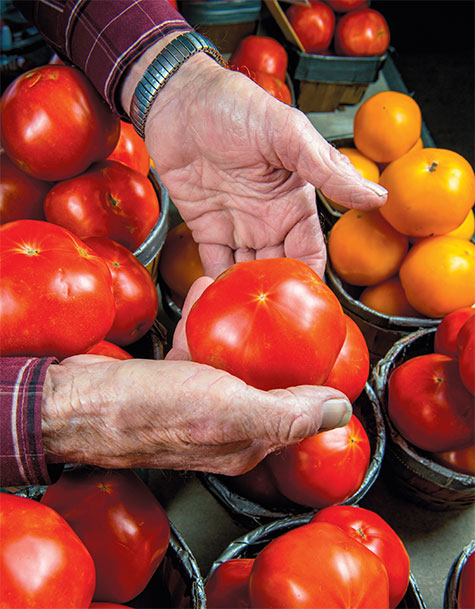
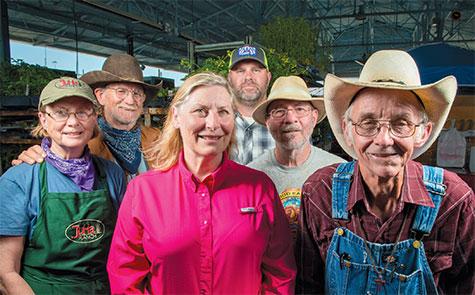 Judi Glasgow & Harry Butaud, JuHa Ranch; Amanda Vanhoozier, Director
Judi Glasgow & Harry Butaud, JuHa Ranch; Amanda Vanhoozier, Director
of Market Operations, Dallas Farmers Market; Doug Williams, Grow It
Forward Farm; Paul Magedson, Good Earth Organic Farm; J.T. Lemley,
Lemley’s Produce & Plants.
Photography by Denise Johnson
Have you ever stopped to wonder what makes local…well…local at area farmers markets? East Texas peaches, sure. North Texas beef – a no-brainer. But what about Oak Cliff Coffee Roasters beans or early-season tomatoes from Marfa? And how come you don’t see iconic Texas Rio Stars, but you do find Alaskan salmon at a handful of markets? What exactly does local mean, anyway?
“I can tell you, we’ve had hours and hours and hours of this discussion,” says Amanda Vanhoozier, “and we’ve never come to the end.” The former community programs manager for Coppell worked with that city’s farmers market since before its inception in 2003. Earlier this year she took the reins at the Dallas Farmers Market, where she’s shaking things up as director of operations.
Some markets take a laissez-faire attitude toward local. They explicitly allow farmers to sell a certain amount of produce the farmer hasn’t grown, sometimes up to 40 percent. Some markets ask that it all be regional, some don’t. That’s how California table grapes and Washington cherries wind up at North Texas markets. You find the interlopers especially at farmers markets that don’t have the resources or inclination to visit every farm or whose administrators believe their customers would rather have a large selection of fresh produce even if it’s not strictly local.
This is where the Marfa tomatoes come in. Available year-round, they are grown in Far West Texas greenhouses. You find them in supermarkets, too, under the Village Farms brand. The thinking goes: People come to the farmers market for tomatoes. Never mind that it’s May, before local field tomatoes have ripened. Let’s be sure they can find Texas tomatoes, even if they’re from faraway hothouses. You rarely see Texas grapefruit from the Rio Grande Valley at neighborhood markets, despite the fact that Harlingen and Marfa are the same distance from Dallas: 520 miles. Perhaps because we don’t grow grapefruit in North Texas, it doesn’t carry the same “local” buzz as tomatoes or peaches.
A few markets go to great lengths to ensure their “local” status. That’s because the people who run them know their customers expect authenticity. “Produce is simple to us – grown within 150 miles,” says Sarah Perry, director of Good Local Markets (White Rock, Lakeside and Vickery Meadow). Her markets, as well as Coppell and the Denton County Farmers Market, are examples of strong “grower” markets, meaning that with rare exceptions the sellers must be the farmers who grow the fruits and vegetables. Close relations count: Don Baugh’s whole family gets involved in selling produce from their Wills Point Baugh Farms. That’s why you can find his heirloom tomatoes, watermelon and more at Good Local Markets, McKinney, Saint Michael’s and Oak Lawn Methodist Church.
“We visit all of our vendors,” Perry says. But there are exceptions, even to Good Local Markets’ 150-mile rule. “One exception is Kitchen Pride (mushrooms),” Perry says. “The family who owns and operates it lives in Corsicana (within the radius). The mushrooms are grown in Gonzales, Texas (260 miles from Dallas).” Another exception is Texas Olive Ranch Olive Oil. “We’ve done our research without visiting Carrizo Springs, Texas (390 miles away),” says Perry. That’s where John and Karen Henry established their olive groves southwest of San Antonio. There wouldn’t be a native olive oil business without their pioneering efforts.
A few markets go to great lengths to ensure
their “local” status. That’s because
the people who run them know
their customers expect authenticity.
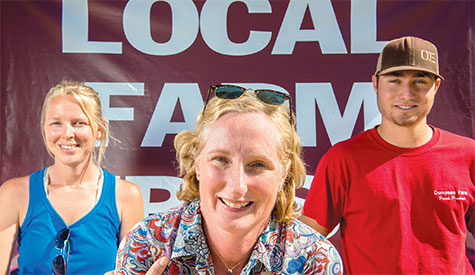 Jennifer Chandler, Chandler Family Farm; Sarah Perry, Executive Director,
Jennifer Chandler, Chandler Family Farm; Sarah Perry, Executive Director,
Good Local Markets; Chris Demases, Demases Farm Fresh Produce
Back when Coppell Farmers Market started in 2003, “local” had to do with the miles produce traveled. “We were looking at it as a transportation issue,” Vanhoozier says. That quickly changed, although the all-volunteer committee that ran the market shied away from rigid distances. “We never said 150-mile radius. What’s 151?”
It became more about “being closer to your source, closer to the hands that produced it.” The committee, part of the Coppell Community Garden, also visits the farms. “I can still close my eyes and see Paul (Magedson) and his lambs,” Vanhoozier says, recalling her first visit to Good Earth Organic Farm in Celeste. “In Coppell, the consumer understands (local) and is more willing to ask questions,” she says. That’s how they develop relationships with farmers. Coppell and Good Local, along with McKinney, have emerged as the area’s top farmers markets, although McKinney is one of those with a 60-40 grower-produce requirement. Despite the looser rules, it has succeeded in building a deep reservoir of farmers who bring what they grow, from Johnson’s Backyard Garden organics (Denton) to father-daughter-run Stonebranch Microfarm (Chambersville) and the Baughs.
But back to that pesky “local” question. What about Oak Cliff Coffee Roasters? Clearly, coffee beans don’t grow in Texas. That’s where the “artisan” in local artisan goods comes in. The defining factor is the uniqueness the locally based producer, maker or baker brings to the product, Vanhoozier says, be it bread or barbecue sauce. Good Local’s Perry offers the example of Chef Milton Atlantic Sea Salts.
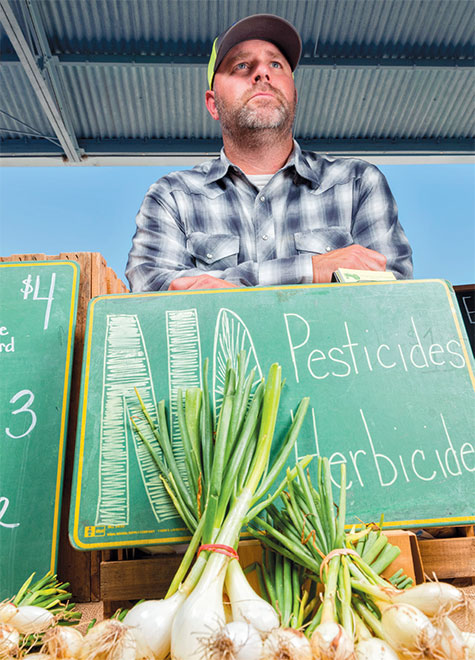 Doug Williams, Grow It Forward Farm
Doug Williams, Grow It Forward Farm
“Obviously salt is not from the United States even,” Perry says. “But he takes the ingredients and creates another product out of it…. It’s not coffee from Oklahoma. It’s not spices from Oregon.” To nuance things further, Vanhoozier says that sometimes local is defined by a relationship. “When we first started Coppell, we had a tea person whose family lives in India and knows the plantations (where the tea came from)….” That’s different from someone who is, in effect, just selling a line of teas. In the case of Oak Cliff Coffee Roasters, Shannon and Jenni Neffendorf not only do custom roasting, they also practice hands-on direct trade with their growers. “Shannon has gone down to the plantation(s),” Vanhoozier says.
Under Vanhoozier’s leadership, the Dallas Farmers Market is making a run for the top ranks, a goal that’s been stymied for years by the preponderance of produce dealers who buy and sell wholesale the same way grocery stores do. Vanhoozier and a team that includes nonprofit GROW North Texas’ Chad Julka and Susie Marshall are changing all that. As of June 1, all permanent stalls and refrigerated semi truck-trailers—and by extension most dealers who buy and resell wholesale produce—are gone. There are Farmers Market Days at The Shed five days a week and Produce Stand Days two days a week.
“Five days a week, vendors will sell natural meats, artisanal cheeses, pastured eggs, jarred jams and pickles, breads and pastries, as well as recently harvested seasonal produce (on Tuesday, Thursday, Friday, Saturday and Sunday),” according to the Dallas Farmers Market press release. Farmers are permitted to sell produce from neighboring farms, but they must provide proof of a relationship, such as receipts. An example is when real Canton farmer J.T. Lemley, a fixture at the Dallas market for decades, sells peas from Sides Pea Farm, also in Canton.
The Produce Stand days (Friday and Monday), following each Night Market, are the only times produce dealers may resell clearly marked nonlocal produce. “No more going over to the warehouse and buying a bunch of (bleep) and putting up a sign that says ‘farmer,’” says Lemley. Tropical fruits are off the floor, too. The Night Market takes place Thursday and Sunday nights and grows out of the Dallas Farmers Market designation as a U.S. Department of Agriculture produce terminal. “We’re totally different because of the Night Market,” Vanhoozier says. That’s where a huge amount of buying and selling takes place. It’s a terminal for truckers hauling fresh-off-the-farm regional produce—the freshest it can be—from states such as Georgia or North Carolina. Local farmers, like Lemley, also sell at the Night Market. The shoppers are chefs and wholesalers.
Some of the fresh, out-of-state produce finds its way to The Shed on Produce Stand Days. Fridays are both a Farmers Market Day and a Produce Stand Day. (I suspect it’s going to take all of us a while —perhaps more than a season—to wrap our heads around these sweeping changes.)
So how, then, do markets shoehorn Alaskan salmon into “local” specs? Vanhoozier explains with the example of Susan Cross, a regular pecan-seller at Coppell. “She has a son who lives in Alaska. He (catches and) ships frozen salmon down.” That’s not very different from the tea dealer whose family connects her to plantations. Each case is individual, Vanhoozier says, considered story by story, and the discussion about what constitutes local continues.
For many folks, this whole debate is a revelation. “Most people don’t have any idea of how this (farming) is done, and the work, labor and money that goes into it,” says Wills Point farmer Baugh. “A lot think this stuff just jumps on the truck and gets to the table.”
HOW LOCAL IS IT?
A good way to find out whether a market is a strict growers market or one with more relaxed criteria is to check the vendor applications on the market’s website. It spells out what vendors can and can’t do. A list of area farmers markets can be found at edibledfw.com.
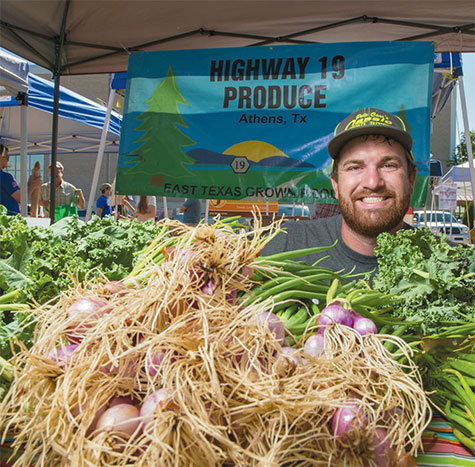 Bobby Bever, Highway 19 Produce & Berries
Bobby Bever, Highway 19 Produce & Berries
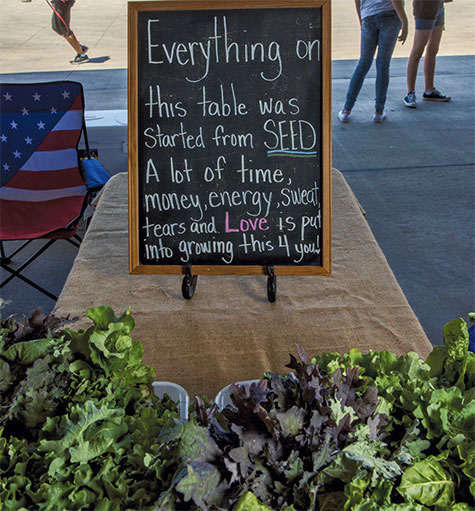
KIM PIERCE is a Dallas freelance writer and editor who’s covered farmers markets and the locavore scene for some 30 years, including continuing coverage at The Dallas Morning News. She came by this passion writing about food, health, nutrition and wine. She and her partner nurture a backyard garden (no chickens – yet) and support local producers and those who grow foods sustainably. Back in the day, she co-authored The Phytopia Cookbook and more recently helped a team of writers win a 2014 International Association of Culinary Professionals Cookbook Award for The Oxford Encyclopedia for Food and Drink in America.
-
Kim Piercehttps://www.edibledfw.com/author/kpierce/
-
Kim Piercehttps://www.edibledfw.com/author/kpierce/
-
Kim Piercehttps://www.edibledfw.com/author/kpierce/
-
Kim Piercehttps://www.edibledfw.com/author/kpierce/











